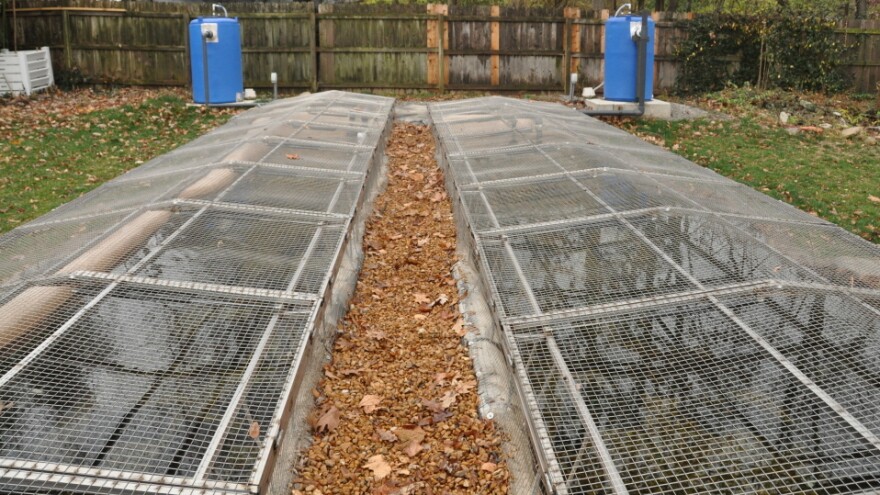It's flat. It's slimy. And it hides under rocks on the river bottom. It's the Ozark hellbender, and at up to two feet in length, it's one of the world's largest salamanders.
But Ozark hellbenders are disappearing: Fewer than 600 are left in the rivers of southern Missouri and northern Arkansas. Scientists have been making a huge effort to get them to breed in captivity. And now, thanks to a major effort at the Saint Louis Zoo, 2012 could be the year of new hope for hellbenders.
The zoo has built a kind of honeymoon resort for salamanders, assembling a mini water treatment plant and carefully tweaking water chemistry to recreate their cold, fast-flowing Ozark streams — minus any distracting predators or pollution.

"What we're looking at is two 40-foot-long raceways or simulated streams that we've constructed over the last two-and-a-half to three years," says Jeff Ettling, the curator for herpetology and aquatics at the zoo. "You'll notice that if you kind of look through the screen, you can see here there's an artificial nest box right here in front of us."
Buried in the gravel stream bed are concrete boxes with a narrow entrance tunnel at one end. They may not sound very comfy, but to a male hellbender, they're the perfect man cave — just what he needs to hunker down, fertilize and guard his stash of eggs.
But a hellbender doesn't exactly fit the image of a romantic Casanova.
"It's got these large wrinkles of skin on the side of its body. And it has a large flat head," says Jeff Briggler, the state herpetologist for the Missouri Department of Conservation. "It looks almost like a pancake, and [it has] little tiny beady eyes. A lot of people think they're not the prettiest animal in the world, but I've grown very fond of them."
A lot of people think they're not the prettiest animal in the world, but I've grown very fond of them.
Zookeeper Chawna Schuette loves them, too, and thinks they've gotten a bad rap.
"They have been called things like 'snot otters' and 'lasagna sides' because they're slimy and they've got frilly little sides on them," Schuette says.
Schuette has been helping to try to breed hellbenders at the zoo because wild hellbenders are in trouble. Development has destroyed a lot of their Ozark habitat; hundreds have been collected for the illegal pet trade, and others have been killed off by pollution and disease.
'There's Fertile Eggs In Here'
All these problems have made hellbender populations plummet. But even more alarming, says the Missouri Department of Conservation's Jeff Briggler, is that young hellbenders have disappeared.
"All we're seeing is these large adults, and once these die off there's not going to be any animals behind them," he says. Briggler says scientists realized if they didn't do something, Ozark hellbenders would soon go extinct. He and others started collecting fertilized eggs to raise them in captivity. And at the Saint Louis Zoo, the hellbender breeding program kicked into high gear.

At first, things didn't go so well.
"We've had females lay eggs, indoors, but the males were not fertilizing the eggs," says Ettling, the zoo project manager. "And when we looked at samples of sperm, they looked like they were malformed. And we just thought we have other problems."
Ettling says that's when they built the outdoor raceways with their high-tech water treatment system. This September, 16 Ozark hellbenders moved in. No one expected them to breed right away.
Then, one chilly October morning, Schuette put on her wetsuit and snorkeling gear to give the hellbenders their weekly checkup.
"And so I was just in the process of collecting animals, recording where they were at, getting weights on them, and all that sort of stuff, as well as checking just in the off-chance that there were eggs," she says. She opened one of the nest boxes.
"I knew right away — I was like, 'there's fertile eggs in here!' And I almost choked on the water in my snorkel, because I was so excited," she says.
Briggler was at the zoo that day, too. "We were, I mean, we were just, I can't even describe it. It excited us tremendously," he says.
A total of 185 have now hatched at the Saint Louis Zoo. Another 1,000-plus will arrive there this spring, raised from wild-fertilized eggs.
They'll stay at the zoo for another six or seven years until they're big enough to be released. The hope is they'll keep the wild population going until researchers can figure out — and fix — whatever is going wrong in the environment.
Copyright 2021 NPR. To see more, visit https://www.npr.org.



